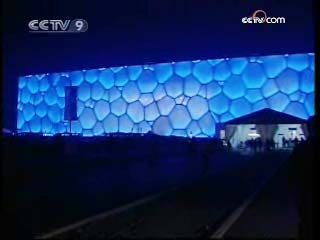------Program code: DO-081219-02203 (what's this?)
Source: CCTV.com
12-19-2008 09:43
 |
In 2006, the American magazine Popular Science conducted research on 100 original architecture projects around the world to select the world’s best architecture design of the year. Not surprisingly, the capital of China, Beijing, attracted their attention.
The building that attracted the attention of the jury members most was the National Aquatic Center, also known as the Water Cube, and the jury voted it the world’s No. 1 design of the year.
 |
Located right opposite the main venue of the Beijing Olympics, the Beijing National Stadium, also known as the “Bird’s Nest,”, the Water Cube is made up of 3065 blue air cushions, and from the outside it looks just like a transparent ice cube.
Together the blue cube and the Bird’s Nest become the highlight of the Beijing Olympic Park. The combination of a circle and a square reflect traditional Chinese aesthetics, as in traditional Chinese belief systems the circle symbolizes the sky and the square the earth.
The exterior of the Water Cube immediately conjures up the feeling of a wonderland, while the interior also creates a spectacular visual effect.
The building’s use of a bubble-wrap structure is a major and significant experiment in architecture, and its successful construction solves the architectural equivalent of the “Goldbach Conjecture”.
It’s been a hundred years since British mathematician Calvin came up with the bubble theory, and in that time nobody had turned the theory into a reality until PTW Architects - an Australian architecture firm - and architects of the China State Construction Engineering Corporation (CSCEC) - came together to design and construct the Water Cube.
The designers faced many issues. Would the transparent air cushions be able to resist the Beijing’s fierce weather? How would the interior be made to match the spectacular exterior? And would there be safety problems hidden in the final construction?
When people first see the apparently light-weight building they are curious and, at the same time, have their doubts. It seems just too light.
